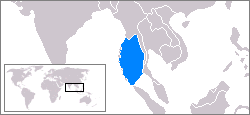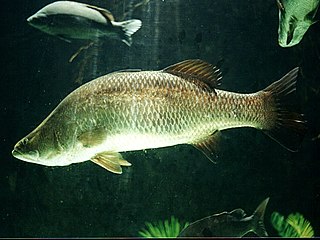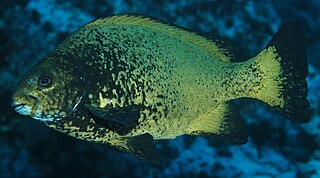Bass is a generic common name shared by many species of ray-finned fish from the large clade Percomorpha, mainly belonging to the orders Perciformes and Moroniformes, encompassing both freshwater and marine species. The word bass comes from Middle English bars, meaning "perch", despite that none of the commonly referred bass species belong to the perch family Percidae.
Sea bass is a common name for a variety of different species of marine fish. Many fish species of various families have been called sea bass.

The Andaman Sea is a marginal sea of the northeastern Indian Ocean bounded by the coastlines of Myanmar and Thailand along the Gulf of Martaban and the west side of the Malay Peninsula, and separated from the Bay of Bengal to its west by the Andaman Islands and the Nicobar Islands. Its southern end is at Breueh Island just north of Sumatra, with the Strait of Malacca further southeast.

The black sea bass is a species of marine ray-finned fish, a sea bass from the subfamily Serraninae which is part of the family Serranidae, which also includes the groupers and anthias. It is found in the western Atlantic Ocean, where it is an important species for commercial and recreational fisheries.

The barramundi, Asian sea bass, or giant sea perch is a species of catadromous fish in the family Latidae of the order Perciformes. The species is widely distributed in the Indo-West Pacific, spanning the waters of the Middle East, South Asia, Southeast Asia, East Asia, and Oceania.

The Waigieu seaperch, or Waigeo barramundi, is a species of marine fish in family Latidae of order Carangiformes. The only species of genus Psammoperca, it is native to tropical coastal waters from the Bay of Bengal in the South through Indonesia to northern Australia and north through the Philippines and the South China Sea to Japan.

The Latidae, known as the lates perches, are a family of perch-like fish found in Africa, Asia, and the Indian and western Pacific Oceans. Including about 13 species, the family, previously classified subfamily Latinae in family Centropomidae, was raised to family status in 2004 after a cladistic analysis showed the original Centropomidae were paraphyletic.
The spikey bass is a species of ray-finned fish in the family Latidae, the lates perches. It is endemic to coastal waters off Western Australia, where it inhabits areas with soft substrates. It is the only species in the monotypic genus Hypopterus.

Saint Martin Island is a small island in the northeastern part of the Bay of Bengal, about 9 km south of the tip of the Cox's Bazar-Teknaf peninsula, and forming the southernmost part of Bangladesh. There is a small adjoining island that is separated at high tide, called Chera Dip. It is about 8 kilometres west of the northwest coast of Myanmar, at the mouth of the Naf River.

Francis Talbot Day was an army surgeon and naturalist in the Madras Presidency who later became the Inspector-General of Fisheries in India and Burma. A pioneer ichthyologist, he described more than three hundred fishes in the two-volume work on The Fishes of India. He also wrote the fish volumes of the Fauna of British India series. He was also responsible for the introduction of trout into the Nilgiri hills, for which he received a medal from the French Societe d'Acclimatation. Many of his fish specimens are distributed across museums with only a small fraction deposited in the British Museum, an anomaly caused by a prolonged conflict with Albert Günther, the keeper of zoology there.

The giant sea bass is a fish native to the North Pacific Ocean. Although commonly referred to as a giant sea bass, black sea bass or giant black sea bass, it is actually a wreckfish in the family Polyprionidae rather than in the sea bass family Serranidae.

The European seabass, also known as the branzino, European bass, sea bass, common bass, white bass, capemouth, white salmon, sea perch, white mullet, sea dace or loup de mer, is a primarily ocean-going fish native to the waters off Europe's western and southern and Africa's northern coasts, though it can also be found in shallow coastal waters and river mouths during the summer months and late autumn. It is one of only six species in its family, Moronidae, collectively called the temperate basses.

Percoidei is one of 3 suborders of bony fishes in the order Perciformes. Many commercially harvested fish species are considered to be contained in this suborder, including the snappers, groupers, basses, goatfishes and perches.

Percoidea is a superfamily of fish of the order Perciformes. The superfamily includes about 3,374 species.

The Japanese sea bass is a species of catadromous marine ray-finned fish from the Asian sea bass family Lateolabracidae which is found in the Western Pacific.

Dissostichus, the toothfish, is a genus of marine ray-finned fish belonging to the family Nototheniidae, the notothens or cod icefish. These fish are found in the Southern Hemisphere. Toothfish are marketed in the United States as Chilean sea bass or less frequently as white cod. "Chilean sea bass" is a marketing name coined in 1977 by Lee Lantz, a fish wholesaler who wanted a more attractive name for selling the Patagonian toothfish to Americans. In 1994, the U.S. Food and Drug Administration (FDA) accepted "Chilean sea bass" as an "alternative market name" for Patagonian toothfish. The toothfish was remarkably successful in the United States, Europe and Asia, and earned the nickname "white gold" within the market. Toothfish are vital to the ecological structure of Southern Ocean ecosystems. For this reason, on 4 September a national day is dedicated to the toothfish in South Georgia.

Sphyraena helleri, the Heller's barracuda, is a schooling species of barracuda in the family Sphyraenidae.
Lates lakdiva is a species of ray-finned fish from the family Latidae, which is only known to occur in western Sri Lanka. It is similar to the barramundi, but its body is not as deep. It is a species of fresh and brackish waters.













